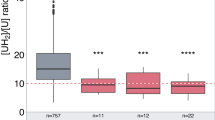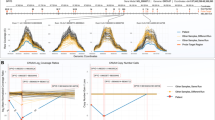Abstract
Purpose
Several clinical guidelines recommend genetic screening of DPYD, including coverage of the variants c.1905 + 1G>A(DPYD*2A), c.1679T>G(DPYD*13), c.2846A>T, and c.1129-5923C>G, before initiating treatment with fluoropyrimidines. However, this screening is often inadequate at predicting the occurrence of severe fluoropyrimidine-induced toxicity in patients.
Methods
Using a complementary approach combining whole DPYD exome sequencing and in silico and structural analysis, as well as phenotyping of DPD by measuring uracilemia (U), dihydrouracilemia (UH2), and the UH2/U ratio in plasma, we were able to characterize and interpret DPYD variants in 28 patients with severe fluoropyrimidine-induced toxicity after negative screening.
Results
Twenty-five out of 28 patients (90%) had at least 1 variant in the DPYD coding sequence, and 42% of the variants (6/14) were classified as potentially deleterious by at least 2 of the following algorithms: SIFT, Poly-Phen-2, and DPYD varifier. We identified two very rare deleterious mutations, namely, c.2087G>A (p.R696H) and c.2324T>G (p.L775W). We were able to demonstrate partial DPD deficiency, as measured by the UH2/U ratio in a patient carrying the variant p.L775W for the first time.
Conclusion
Whole exon sequencing of DPYD in patients with suspicion of partial DPD deficiency can help to identify rare or new variants that lead to enzyme inactivation. Combining different techniques can yield abundant information without increasing workload and cost burden, thus making it a useful approach for implementation in patient care.


Similar content being viewed by others
Abbreviations
- DPYD :
-
Dihydropyrimidine dehydrogenase gene
- DPD:
-
Dihydropyrimidine dehydrogenase protein
- 5-FU:
-
5-Fluorouracil
- ADRs:
-
Adverse drug reactions
- CPIC:
-
Clinical Pharmacogenetics Implementation Consortium
- SNP:
-
Single-nucleotide polymorphism
- EMA:
-
European Medicines Agency
- SIFT:
-
Sorting intolerant from tolerant
- CTCAE:
-
Common terminology criteria for adverse events
- U:
-
Uracil
- UH2 :
-
Dihydrouracil
- FMN:
-
Flavin mononucleotide
References
Brito RA, Medgyesy D, Zukowski TH et al (1999) Fluoropyrimidines: a critical evaluation. Oncology 57:2–8
Onesti CE, Botticelli A, La TM et al (2016) 5-Fluorouracil degradation rate could predict toxicity in stages II-III colorectal cancer patients undergoing adjuvant FOLFOX. Anticancer Drugs 28:322–326. https://doi.org/10.1097/CAD.0000000000000453
Heggie GD, Sommadossi JP, Cross DS et al (1987) Clinical pharmacokinetics of 5-fluorouracil and its metabolites in plasma, urine, and bile. Cancer Res 47:2203–2206
Chazal M, Etienne MC, Renée N et al (1996) Link between dihydropyrimidine dehydrogenase activity in peripheral blood mononuclear cells and liver. Clin Cancer Res 2:507–510
Gamelin E, Boisdron-Celle M, Guérin-Meyer V et al (1999) Correlation between uracil and dihydrouracil plasma ratio, fluorouracil (5-FU) pharmacokinetic parameters, and tolerance in patients with advanced colorectal cancer: a potential interest for predicting 5-FU toxicity and determining optimal 5-FU dosage. J Clin Oncol 17:1105. https://doi.org/10.1200/JCO.1999.17.4.1105
Boisdron-Celle M, Remaud G, Traore S et al (2007) 5-Fluorouracil-related severe toxicity: a comparison of different methods for the pretherapeutic detection of dihydropyrimidine dehydrogenase deficiency. Cancer Lett 249:271–282. https://doi.org/10.1016/j.canlet.2006.09.006
Meulendijks D, Henricks LM, Jacobs BAW et al (2017) Pretreatment serum uracil concentration as a predictor of severe and fatal fluoropyrimidine-associated toxicity. Br J Cancer 116:1415–1424. https://doi.org/10.1038/bjc.2017.94
Amstutz U, Froehlich TK, Largiadèr CR (2011) Dihydropyrimidine dehydrogenase gene as a major predictor of severe 5-fluorouracil toxicity. Pharmacogenomics 12:1321–1336. https://doi.org/10.2217/pgs.11.72
Meulendijks D, Henricks LM, Sonke GS et al (2015) Clinical relevance of DPYD variants c.1679T>G, c.1236G>A/HapB3, and c.1601G>A as predictors of severe fluoropyrimidine-associated toxicity: a systematic review and meta-analysis of individual patient data. Lancet Oncol 16:1639–1650. https://doi.org/10.1016/S1470-2045(15)00286-7
Terrazzino S, Cargnin S, Del Re M et al (2846A) DPYD IVS14+1G>A and 2846A>T genotyping for the prediction of severe fluoropyrimidine-related toxicity: a meta-analysis. Pharmacogenomics 14:1255–1272. https://doi.org/10.2217/pgs.13.116
Henricks LM, Opdam FL, Beijnen JH et al (2017) DPYD genotype-guided dose individualization to improve patient safety of fluoropyrimidine therapy: call for a drug label update. Ann Oncol Off J Eur Soc Med Oncol 28:2915–2922. https://doi.org/10.1093/annonc/mdx411
Amstutz U, Henricks LM, Offer SM et al (2018) Clinical pharmacogenetics implementation consortium (CPIC) guideline for dihydropyrimidine dehydrogenase genotype and fluoropyrimidine dosing: 2017 update. Clin Pharmacol Ther 103:210–216. https://doi.org/10.1002/cpt.911
EMA review capecitabine. https://www.ema.europa.eu/en/medicines/human/referrals/fluorouracil-fluorouracil-related-substances-capecitabine-tegafur-flucytosine-containing-medicinal. Accessed 23 Oct 2019
Cortejoso L, García-González X, García MI et al (2016) Cost-effectiveness of screening for DPYD polymorphisms to prevent neutropenia in cancer patients treated with fluoropyrimidines. Pharmacogenomics 17:979–984. https://doi.org/10.2217/pgs-2016-0006
Karczewski KJ, Francioli LC, Tiao G, et al (2019) Variation across 141,456 human exomes and genomes reveals the spectrum of loss-of-function intolerance across human protein-coding genes. bioRxiv 531210. https://doi.org/10.1101/531210
García-González X, López-Fernández LA (2017) Using pharmacogenetics to prevent severe adverse reactions to capecitabine. Pharmacogenomics 18:1199–1213. https://doi.org/10.2217/pgs-2017-0102
Adzhubei IA, Schmidt S, Peshkin L et al (2010) A method and server for predicting damaging missense mutations. Nat Methods 7:248–249. https://doi.org/10.1038/nmeth0410-248
Kumar P, Henikoff S, Ng PC (2009) Predicting the effects of coding non-synonymous variants on protein function using the SIFT algorithm. Nat Protoc 4:1073–1081. https://doi.org/10.1038/nprot.2009.86
Shrestha S, Zhang C, Jerde CR et al (2018) Gene-specific variant classifier (DPYD-Varifier) to identify deleterious alleles of dihydropyrimidine dehydrogenase. Clin Pharmacol Ther 104:709–718. https://doi.org/10.1002/cpt.1020
García-González X, López-Tarruella S, García MI et al (2018) Severe toxicity to capecitabine due to a new variant at a donor splicing site in the dihydropyrimidine dehydrogenase (DPYD) gene. Cancer Manag Res 10:4517–4522. https://doi.org/10.2147/CMAR.S174470
Vaser R, Adusumalli S, Leng SN et al (2016) SIFT missense predictions for genomes. Nat Protoc 11:1–9. https://doi.org/10.1038/nprot.2015.123
Offer SM, Fossum CC, Wegner NJ et al (2014) Comparative functional analysis of DPYD variants of potential clinical relevance to dihydropyrimidine dehydrogenase activity. Cancer Res 74:2545–2554. https://doi.org/10.1158/0008-5472.CAN-13-2482
Sistonen J, Büchel B, Froehlich TK et al (2014) Predicting 5-fluorouracil toxicity: DPD genotype and 5,6-dihydrouracil:uracil ratio. Pharmacogenomics 15:1653–1666. https://doi.org/10.2217/pgs.14.126
Offer SM, Wegner NJ, Fossum C et al (2013) Phenotypic profiling of DPYD variations relevant to 5-fluorouracil sensitivity using real-time cellular analysis and in vitro measurement of enzyme activity. Cancer Res 73:1958–1968. https://doi.org/10.1158/0008-5472.CAN-12-3858
Desmet F-O, Hamroun D, Lalande M et al (2009) Human splicing finder: an online bioinformatics tool to predict splicing signals. Nucleic Acids Res 37:e67. https://doi.org/10.1093/nar/gkp215
Parthiban V, Gromiha MM, Schomburg D (2006) CUPSAT: prediction of protein stability upon point mutations. Nucleic Acids Res 34:W239–W242. https://doi.org/10.1093/nar/gkl190
Huang CC, Meng EC, Morris JH et al (2014) Enhancing UCSF Chimera through web services. Nucleic Acids Res 42:W478–W484. https://doi.org/10.1093/nar/gku377
Dobritzsch D, Schneider G, Schnackerz KD, Lindqvist Y (2001) Crystal structure of dihydropyrimidine dehydrogenase, a major determinant of the pharmacokinetics of the anti-cancer drug 5-fluorouracil. EMBO J 20:650–660. https://doi.org/10.1093/emboj/20.4.650
Thomas F, Hennebelle I, Delmas C et al (2016) Genotyping of a family with a novel deleterious DPYD mutation supports the pretherapeutic screening of DPD deficiency with dihydrouracil/uracil ratio. Clin Pharmacol Ther 99:235–242. https://doi.org/10.1002/cpt.210
Loriot M-A, Ciccolini J, Thomas F et al (2018) Dihydropyrimidine déhydrogenase (DPD) deficiency screening and securing of fluoropyrimidine-based chemotherapies: update and recommendations of the French GPCO-Unicancer and RNPGx networks. Bull Cancer 105:397–407. https://doi.org/10.1016/j.bulcan.2018.02.001
van Kuilenburg ABP, Dobritzsch D, Meinsma R et al (2002) Novel disease-causing mutations in the dihydropyrimidine dehydrogenase gene interpreted by analysis of the three-dimensional protein structure. Biochem J 364:157–163. https://doi.org/10.1042/bj3640157
Etienne-Grimaldi MC, Boyer JC, Beroud C et al (2017) New advances in DPYD genotype and risk of severe toxicity under capecitabine. PLoS ONE 12:1–19. https://doi.org/10.1371/journal.pone.0175998
Henricks LM, Meulendijks D, Swen JJ (2015) Translating DPYD genotype into DPD phenotype: using the DPYD gene activiy score. Pharmacogenomics 16:1275–1284
Tozer T, Heale K, Manto Chagas C et al (2019) Interdomain twists of human thymidine phosphorylase and its active-inactive conformations: binding of 5-FU and its analogues to human thymidine phosphorylase versus dihydropyrimidine dehydrogenase. Chem Biol Drug Des 94:1956–1972. https://doi.org/10.1111/cbdd.13596
Etienne-Grimaldi M-C, Boyer J-C, Beroud C et al (2017) New advances in DPYD genotype and risk of severe toxicity under capecitabine. PLoS ONE 12:e0175998. https://doi.org/10.1371/journal.pone.0175998
Gross E, Ullrich T, Seck K et al (2003) Detailed analysis of five mutations in dihydropyrimidine dehydrogenase detected in cancer patients with 5-fluorouracil-related side effects. Hum Mutat 22:498. https://doi.org/10.1002/humu.9201
van Kuilenburg ABP, Meijer J, Tanck MWT et al (2016) Phenotypic and clinical implications of variants in the dihydropyrimidine dehydrogenase gene. Biochim Biophys Acta Mol Basis Dis 1862:754–762. https://doi.org/10.1016/j.bbadis.2016.01.009
Amstutz U, Farese S, Aebi S, Largiadèr CR (2009) Dihydropyrimidine dehydrogenase gene variation and severe 5-fluorouracil toxicity: a haplotype assessment. Pharmacogenomics 10:931–944. https://doi.org/10.2217/pgs.09.28
Del Re M, Quaquarini E, Sottotetti F et al (2016) Uncommon dihydropyrimidine dehydrogenase mutations and toxicity by fluoropyrimidines: a lethal case with a new variant. Pharmacogenomics 17:5–9. https://doi.org/10.2217/pgs.15.146
Rosmarin D, Palles C, Pagnamenta A et al (2015) A candidate gene study of capecitabine-related toxicity in colorectal cancer identifies new toxicity variants at DPYD and a putative role for ENOSF1 rather than TYMS. Gut 64:111–120. https://doi.org/10.1136/gutjnl-2013-306571
Pellicer M, García-González X, García MI et al (2017) Use of exome sequencing to determine the full profile of genetic variants in the fluoropyrimidine pathway in colorectal cancer patients affected by severe toxicity. Pharmacogenomics 18:1215–1223. https://doi.org/10.2217/pgs-2017-0118
Del Re M, Cinieri S, Michelucci A et al (2019) DPYD*6 plays an important role in fluoropyrimidine toxicity in addition to DPYD*2A and c.2846A>T: a comprehensive analysis in 1254 patients. Pharmacogenom J 19:556–563. https://doi.org/10.1038/s41397-019-0077-1
Iachetta F, Romagnani A et al (2019) The clinical relevance of multiple DPYD polymorphisms on patients candidate for fluoropyrimidine based-chemotherapy. An Italian case–control Study. Br J Cancer. https://doi.org/10.1038/S41416-019-0423-8
Boige V, Vincent M, Alexandre P et al (2016) DPYD genotyping to predict adverse events following treatment with flourouracil-based adjuvant chemotherapy in patients with stage III colon cancer: a secondary analysis of the PETACC-8 randomized clinical trial. JAMA Oncol 2:655–662. https://doi.org/10.1001/jamaoncol.2015.5392
Pellicer M, García-González X, García MI et al (2017) Identification of new SNPs associated with severe toxicity to capecitabine. Pharmacol Res 120:133–137. https://doi.org/10.1016/j.phrs.2017.03.021
García-González X, Cortejoso L, García MI et al (2015) Variants in CDA and ABCB1 are predictors of capecitabine-related adverse reactions in colorectal cancer. Oncotarget 6:6422–6430. https://doi.org/10.18632/oncotarget.3289
Acknowledgements
The authors would like to thank Rafael Gras and Debanjana Chatterjee for revising the English language used in the manuscript. We are also grateful to the Genome Aggregation Database (gnomAD) and the groups that provided exome and genome variant data to this resource.
Funding
This work was supported by Consejería de Educación y Deporte de la Comunidad de Madrid (Grant numbers PEJ16/MED/AI-1260 and PEJD-2018-PRE/BMD-8665) and by the Gregorio Marañón Health Research Institute (Grant numbers PRE-2018-2 and PI-2-2019). The study was cofunded by ERDF Funds (FEDER) from the European Commission, “A way of making Europe”.
Author information
Authors and Affiliations
Corresponding author
Ethics declarations
Conflict of interest
The authors declare no conflicts of interest. The funders had no role in the design of the study, in the collection, analysis, or interpretation of data, in the writing of the manuscript, or in the decision to publish the results.
Additional information
Publisher's Note
Springer Nature remains neutral with regard to jurisdictional claims in published maps and institutional affiliations.
Electronic supplementary material
Below is the link to the electronic supplementary material.
Rights and permissions
About this article
Cite this article
García-González, X., Kaczmarczyk, B., Abarca-Zabalía, J. et al. New DPYD variants causing DPD deficiency in patients treated with fluoropyrimidine. Cancer Chemother Pharmacol 86, 45–54 (2020). https://doi.org/10.1007/s00280-020-04093-1
Received:
Accepted:
Published:
Issue Date:
DOI: https://doi.org/10.1007/s00280-020-04093-1




